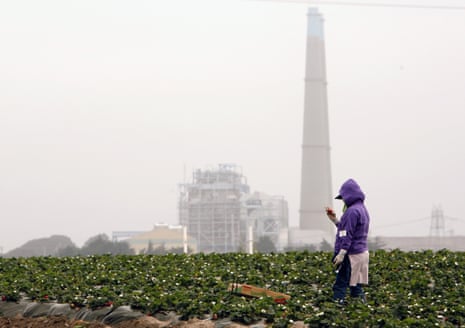The strawberries that Juan Reyes hand-picked had turned gray from the ash falling from the sky, yet nobody provided him and his fellow farmworkers with any protective face coverings until the next day.
As hundreds of fires burn across California, blanketing swaths of the state in smoke so thick that it muted the sun, low-wage farmworkers continued to toil in the fields, working through grueling conditions, now made even worse by the air quality.
“My throat was hurting,” Reyes, 38, said in Spanish. “There’s difficulty breathing. When I got home, my chest was hurting a lot.”
A vulnerable, essential labor force already disproportionately impacted by the coronavirus pandemic kept working as others fled and took shelter. More than 381,000 people across California work in the frontline essential agriculture industry, according to the Community and Labor Center at the University of California, Merced, from the lush almond tree orchards in the north to the cornfields of the Central Valley.

Farmworkers already worked in conditions that were ripe for abuse and exploitation, worker rights organizations say. And with larger and more destructive wildfires arriving with each coming year in California, advocates have found it even more difficult to protect their rights.
Farm workers don't get to use Zoom to harvest our food. Ramiro sent us this photo from Salinas CA where he is currently harvesting lettuce during the wildfires, despite the air quality being "very unhealthy ." #WeFeedYou pic.twitter.com/VRmXexmxUa
— United Farm Workers (@UFWupdates) August 20, 2020
“Whether it’s wildfire, pandemic, drought or storm, farmworkers are out in the field,” said Lucas Zucker, the policy and communications director for the Central Coast Alliance United for a Sustainable Economy. “It’s a largely immigrant workforce, many undocumented. Many are from indigenous communities from southern Mexico who face even greater barriers to accessing services and reporting labor abuses.”
Farmworkers in California are “particularly vulnerable”, he continued, because of the nature of the crops and the industry. “It’s extremely labor-intensive crops that require a lot of people out in the fields picking by hand. You’ll see thousands of workers out there picking strawberries, as opposed to Iowa, where there are cornfields where it’s mostly automated.”
In Santa Cruz county, where Reyes picks strawberries, more than 20,000 people have been ordered to evacuate as the CZU August Lightning Complex fire grew to 40,000 acres.

To his south lies Steinbeck country, the lush agricultural valley of the Central Coast that was the setting for the Grapes of Wrath. Here, the Carmel fire burns at 4,285 acres and 0% containment and the River fire at 33,653 acres and 7% containment. Farther south on the coast, about 10 miles from Big Sur, the Dolan fire grew to 6,700 acres.
Together, these fires formed a heavy cloud of smoke that hung overhead as these workers picked their crops. State regulations require companies to provide workers with masks when the air quality reaches a certain threshold of very bad, Zucker said, but that doesn’t always happen. The agriculture industry in general is very segmented, with layers of contracting and subcontracting. Safety protocols established by a company, Zucker explained, may not reach the ones tasked with hiring and overseeing the fieldworkers.
“Because of who most farmworkers are, because of the culture that has developed in agriculture, there are a lot of workers who don’t receive the safety conditions that are on paper,” he said. “There is also often a culture where if you speak up or say you don’t want to work, you may be seen as someone who is lazy or doesn’t want to work and you may not be called back for the next harvest.”
Compounding this year’s smoke exposure is a virus that affects the lungs.
“Even before Covid-19, we saw a huge problem with the lack of N95 masks for farmworkers during wildfires,” Zucker said. “Now it’s gotten even worse because it’s much more difficult to get N95 masks because a lot of them have gone to hospitals in the past few months.”
Reyes, who asked not to name the company he worked for out of fear that he would lose his job, said he and his fellow workers did not get masks for the first day the smoke was heavy over Santa Cruz county. He worked a 10-hour shift that day with no protection.
The next day, he brought his own surgical mask and found that the company had provided his coworkers with the same mask – even though for smoke inhalation, the only mask that truly provides any sort of protection is an N95.

Some of his coworkers opted not to wear the mask because it was so hot out, Reyes said. That’s another issue, Zucker said, workplaces need to provide safety education on top of protective gear so that workers can understand why they need to wear their protective gear. “There are a lot of things people don’t know about the long term exposure to wildfire smoke that you as a worker would think, ‘Hey I’m exposed every day to dust and pesticides and I’m tough and can push through’,” he said.
Paid time off and sick days are not an option in this line of work. On wildfire days, Reyes knows he has the option to put his health first and not go to work that day, to not earn his $5.50 an hour and $1.60 per box filled. But in a state with as high a cost of living as California has, every shift counts. “Who is going to pay the bills?” he asked.
“People often want to say thank you to the farmworkers for feeding us and certainly we should all be grateful for the huge sacrifice that workers are marking,” Zucker said. “But people are pushed to make an impossible choice during something like a pandemic or a wildfire.”
This article was updated on 23 August 2020 to correct the number of frontline workers in California’s agriculture industry.
